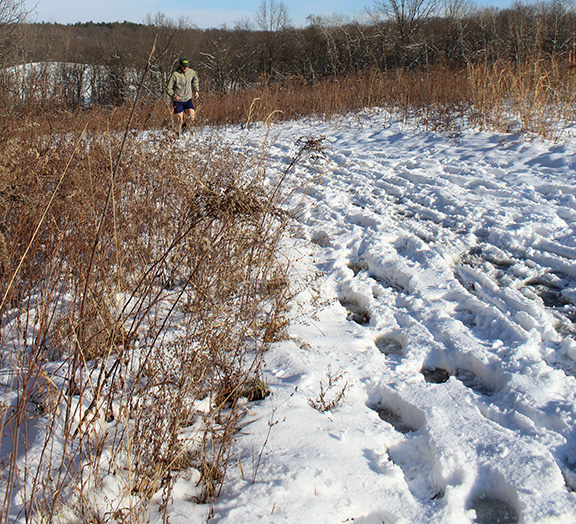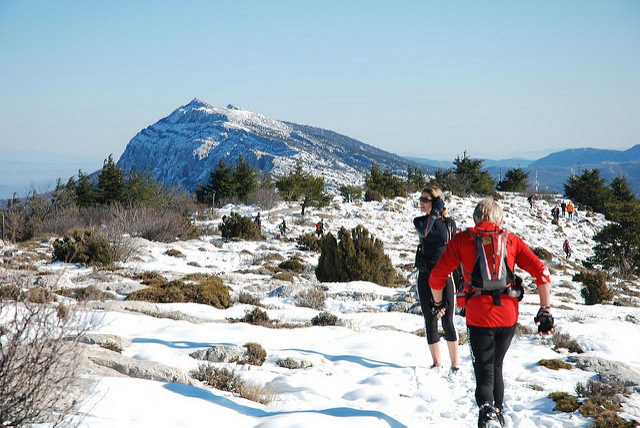Last updated on April 14th, 2021 at 05:28 pm
To most, wintry weather brings the temptation to stay inside where it’s safe, warm, and comfortable. But not you. You love the blustery wind. The cold is your friend. You breathe it in and rejoice as the crisp, dry air fills your lungs. Whether you know it or not you have become addicted to the benefits of trail running in cold weather.
There are many benefits to running in general. Getting out on the trails in the colder months comes with its own particular set of benefits that shouldn’t be overlooked. Below are seven benefits of trail running in cold weather.
1. Improve your heart health (when done safely)
Running in the cold can help to condition and strengthen your heart as it doesn’t have to perform in the same strenuous conditions as hot weather. Using responsible running practices in the cold actually requires less energy, and therefore less work for your heart, than running in hot weather. Because of this your body can operate more efficiently and you can improve your endurance.
It is important to note that winter weather does come with an uptick in heart attacks nationally, and there are a number of theories as to why this happens. When exercising in the cold, the body’s blood vessels contract which leads to higher blood pressure and higher risk of heart attack or stroke. When the heart has to work harder to maintain body temperature in order to avoid hypothermia, the heart is at risk of damage. Therefore, it is important to wear appropriate attire in order to stay warm while running in the cold. Your heart will thank you.
2. Become a More Technical Runner
If running isn’t just an exercise activity for you, if it’s something that you love and want to get better at in order to compete in trail races, then cold weather running is an excellent form of technical training. Winter terrains bring challenges that just don’t present themselves in the summer months.

The presence of snow, ice, sleet, and other winter obstacles requires you to always be alert. Keeping your mind sharp and eyes always scanning the path ahead will allow you to make the right move in order to avoid an obstacle and potential injury. Your body will become comfortable in making constant adjustments to maintain pace and avoid danger in the most treacherous conditions. With time your technical running skills will be on point and your risk of biting it on the ice will be minimized.
3. Burn More Calories
When the weather is cold, the body automatically kicks into gear in order to maintain core warmth and avoid dropping to dangerously low body temperatures. The most obvious sign of this body warming process is shivering. This simple behavior burns calories and even utilizes white and brown fat cells to generate heat. This means that you are burning calories with your muscles and your fat stores, which can potentially help you to lose weight.
4. Strength Training
Sometimes it snows hard. When there are multiple inches of buildup out on the trails, there is no way around it. For some, heavy snow days are a convenient excuse to stay in and binge on Netflix. For you, it’s a perfect opportunity to work on strengthening your muscles. Pouncing through the snow with longer, more exaggerated movements and more effort to maintain balance can almost serve as a plyometric exercise. Your body’s constant, tense focus on avoiding a fall in the harsh conditions also serves as an excellent core exercise.
5. Mental Toughness
Trail runners are naturally mentally tough, but not all trail runners can brave the cold. Getting outside in the chill when every ounce of your body tells you that you shouldn’t train you to endure challenges that you didn’t think you could. Just like any goal, taking the first step can be downright painful- you just don’t want to do it. This will assuredly be the same feeling you’ll have when you make that first winter run. It will be difficult to breathe, the cold air will make your eyes water, and your muscles just won’t act right. You’ll come home and feel like you have been through a fight. And then, you’ll go out there and fight it again. And again. Your body will start to acclimate to the conditions it is constantly being put through and it will begin to get easier.
Getting outside for a winter run on the trails can also help to boost your mood in general. Winter has taken many indoor victims through seasonal affective disorder, but getting outside to take in the stimulating chill of the air, absorb the winter sun, and appreciate the beautiful canvas of white snow that blankets the landscape can really support your mental health.
6. Improved Hydration / Water Retention
As with any workout, it is important to maintain appropriate hydration. One benefit of cold weather running is the fact that the body is doing less work. As a result, it may require less water. Because of this, people often forget to ensure appropriate water consumption before, during, and after trail running.
Another element to consider when running in the cold is how to manage sweating when your body does heat up. No, you likely won’t sweat as much as during summer days, but it still happens.
If you sweat too much in the cold you can find yourself in a dangerous situation when facing wind chill.
The best way to manage this is to dress in layers for a cold-weather trail run. You’ll need to experiment with base layers that wick moisture away. Thicker mid-layers with waterproof and breathable outer layers can help you find a balance to regulate body temperature.
When your body starts to get hot and you begin to sweat, take off a layer. When you get cold again, put it back on. This will require some trial and error to get it right.
7. Train for Mountain Running
For those of you with an interest in scaling the peaks, you’ll have to be prepared for unpredictable mountain weather. Weather changes are almost inevitable as you increase elevation, and it is likely you’ll run into cold circumstances on the mountain trail.

Begin preparing for this by running in the cold on flatter terrain, and as your body acclimates you can incorporate more elevation changes in your run. Mountain running requires an exceptional degree of mental toughness and physical strength, and all of the cold weather running benefits described above can help you reach the peak.
Important Safety Tips for Exercising in Cold Weather
None of the health benefits that have been described will matter if safety precautions are not taken when exercising in cold weather. Irresponsible behavior in dire winter conditions can endanger you in ways that you just don’t consider when the weather is warmer. Below is a review of safety tips to consider before you lace up. Some of these tips were already mentioned in the health benefits described above, but they are captured below as a reiteration of their importance.
Consult with your doctor if you have existing health conditions
If you have asthma, heart conditions, or any other health issue, it is possible that exerting yourself in a cold climate makes you more vulnerable than normal. Before taking any risks, have a conversation with your doctor on the best approach to winter running.
Check the weather before going out
Sometimes it’s just too dangerous to work out in the cold, especially if the wind chill reaches certain levels and your skin is exposed. It can take less than 30 minutes to get frostbite when the wind chill reaches minus 18℉.
If your body is exposed too long in extremely cold conditions, frostbite and hypothermia can occur. Early signs of frostbite include stinging skin and numbness. Hypothermia occurs when your body temperature becomes dangerously low. If you feel abnormally fatigued, suddenly lose coordination, or have slurred speech, these can be early signs of hypothermia.
Warm-up thoroughly
It is important that your muscles are appropriately loosened up prior to going on a run in the cold, especially if the terrain will be challenging. Since your body is going to naturally tense up when you get outside, starting a run without properly warming up your arms and legs can lead to injury.

Take time to move around a bit before getting out on the trail, and while stretching is an important aspect of a warm-up for most, care should be taken to do some form of a dynamic warm-up. By dynamic warm-up, I am simply referring to a type of warm-up that engages muscle groups and ligaments in a more active way than stretching.
Dress appropriately for exercising in cold climates
Wearing enormous, heavy clothing when exercising in winter may prove to be challenging. Even though it’s cold out, your body is going to produce a lot of heat once you get moving. If you are wearing unmanageable clothing, your body is going to start to sweat profusely which can be dangerous when the outside air hits you.

Instead, dress in layers that you can take off when you get hot and put back on when you begin to cool off. Also, be sure that your clothing is not too tight. If your body is too constricted, it will be difficult for your blood to flow freely, which can lead to heat loss. Consider this approach to layering:
Layer closest to skin
Moisture-wicking material such as lightweight polyester
Mid-layer
Insulating materials such as wool or fleece
Outer layer
Thin, wind and water-repellent material, like a waterproof shell jacket
In addition to protecting your core, you should also protect your head and limbs. Wearing a hat will eliminate a lot of heat loss from your head, and be sure to wear gloves and moisture-wicking socks to ensure that your extremities stay warm. In cold weather, the body tends to generate and retain heat in the core of your body, so your limbs are most at risk of becoming cold quicker.
Get noticed with safety gear
Since the weather is less outdoor-friendly than warmer months, drivers may not expect to see you running roadside in the winter. Ice and snow also make it harder for drivers to react when they are heading toward a hazard. Be smart and wear colorful or reflective gear to get noticed early and often. With safety in mind, also consider reading, 8 Tips for Winter Trail Running | Take These Steps to Stay on Track.
Wear sunscreen
It’s easy to forget that the sun is still there in the winter months, but it is! Be sure to wear sunscreen to avoid sunburn, especially when running at high altitudes.
Hydrate often
Winter is dry and your body processes slow down. For this reason, be more intentional when hydrating for cold-weather trail running. Drink plenty of fluids before, during, and after your run.
Reap the Rewards of Winter Running
The ice-covered trails provide new challenges to an otherwise predictable and over-trodden route. You welcome the snow and can’t wait to get out there because comfort is the enemy of progress, and nothing is going to stop you from getting where you want to be: better.
Put on the gear, take a step out into the snow, take a deep breath, and start moving. Your next cold-weather trail run will be your best, and the one after that will be better. It’s going to hurt, and it’s going to feel great.
RELATED:
- Best Cold Compression Therapy Machines | Elite Athlete Recovery
- Best GPS Watches For Trail Running & Ultrarunning
- 5 Reasons Road Runners MUST Add Trail Running to Their Routine
- Best Men’s Trail Running Shoes
- Best Women’s Trail Running Shoes
Stephen Boisvert (https://www.flickr.com/photos/srboisvert/)Attribution 2.0 Generic (CC BY 2.0), akunamatata(https://www.flickr.com/photos/akunamatata/) Attribution-NoDerivs 2.0 Generic (CC BY-ND 2.0)

